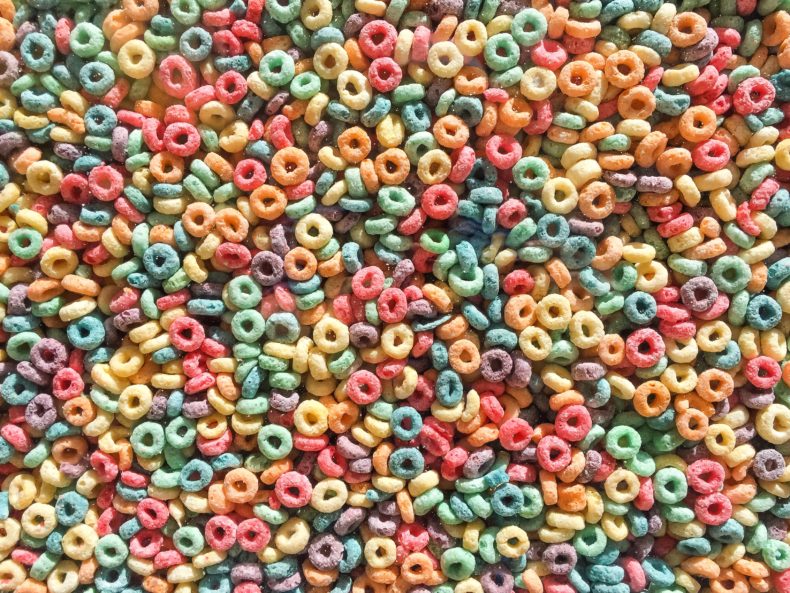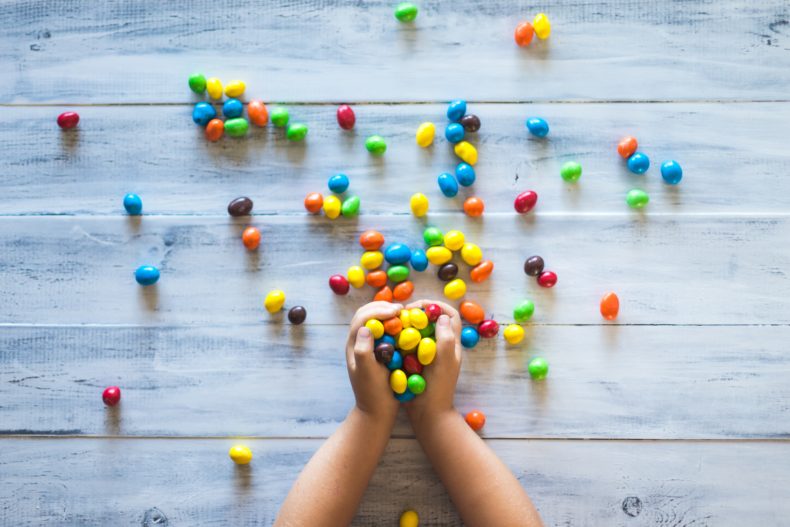
[This post ran some years back. I’ve been thinking again about food and gut health and all the bad stuff we do to ourselves, so I thought I’d re-run it. I mean, eat what you like. But be mindful of all the things.]
—–
Here’s what I remember eating as a kid: Oscar Mayer bologna and American cheese (the individually wrapped slices) on white bread. Peanut butter and jelly on white bread. Honey and butter (yup!) on white bread. Grilled American cheese on white toast. Hot dogs on white buns. Deli ham on big puffy white Kaiser rolls.
Why not? After all, white bread was “enriched”! Doesn’t that sound healthy? Never mind that the bread-refining process that made Wonder such a wonder got rid of the naturally occurring nutritious bits (e.g., the mineral-rich grain coatings); “enriching” the bread was the industry’s attempt to put some of those nutrients back. I just remember how pure and soft and spongy the slices were. And it never went bad. And the label promised a loaf full of vitamins and minerals. It didn’t occur to us we were being deprived of anything, or that we were swallowing anything but good nutrition.
Then there was the cereal. Lots of it. Rice Krispies dominated, plus Corn Flakes and Cheerios (the latter isn’t so bad, right?). Fruit Loops were my true favorite, then Frosted Flakes and marshmallow-flecked Lucky Charms. A clever girl like me knew just how long to soak Captain Crunch in milk to eliminate its gum-slicing edges, and I was the master at stirring the sugar into hot Cocoa Wheat to get that melted-candy swirl on my spoon.
We ate margarine, the “healthy” alternative to butter. We drank milk with its fat removed. We shoveled down Uncle Ben’s “enriched” white rice, egg noodles with low-fat sour cream, spaghetti with plain Ragu sauce from a jar. My favorite: Kraft Mac and Cheese from the box, with the little pouch of orange powder (cheese?) to which you added milk to make the sauce.
We loved Hawaiian Punch from the big can. Country Time lemonade from powder. Juices from concentrate. Coke, poured from tall, skinny glass bottles.
Salad was a hunk of iceberg lettuce with French dressing and maybe a slice of tomato. Vegetables were canned peas or corn or green beans (French cut, if my mom was feeling sassy at the Dominic’s), or raw carrots, celery, and tomato. Ketchup, with as much sugar in a tablespoon as you get in cookie, was our go-to condiment.
[Side note: My husband recalls an acquaintance who was once a condiment company employee telling this story: There was a giant bin of misshapen, dripping, rotting tomatoes, utterly disgusting, in the warehouse. The guy asked if he should throw them out. Answer: “Nope. They’re for the ketchup.”]
Did we eat fresh fruit? Sure. My lunch bag was always corner-heavy with an apple—usually the mis-named Red Delicious—or a banana. And we loved grapefruit (the skins of which my stepdad, in medical school at the time, used to suture up for practice). Berries were expensive, so just an occasional treat. More often we had “fruit cocktail” from the can. That’s mushy “fruit” bits in syrup, for those who missed out.
Besides that bland apple, my brown-bag lunch included one of the previously mentioned white-bread sandwiches, an air-puffed bag of Fritos or Cheetos, and a Hostess Ho-Ho or Twinkie. The amount of sugar and other baddies in that bag? I’m afraid to calculate.
At dinner, the mandated single stalk of asparagus—over-boiled into a limp finger–might reach my gut on occasion, by way of tiny nibbles (oh, the tears! The whining!) washed down with great drama by large gulps of milk. The stinking, soggy Brussel sprout landed in the bottom of the milk glass; the broccoli floret, also boiled to death, got spit into my napkin as I “wiped” my mouth. Other greens? Can’t recall many.
Protein, yes. There was chicken, pork chops, hotdogs, burgers, and occasionally steak. (My mom sometimes tried to pass off liver as steak. Nope.) Fish? Ha! She tried now and then. But all we could afford was the frozen kind, and it ended up as a flavorless strip of oven-broiled nothing that smelled like…fish. Another nope.
I feel I should add this here: Poor Mom. We were such picky brats and she was so, so tired. She did the best she could. I know she did.
But when it became fashionable to buy low-fat this and low-calorie that, we fell in line with everyone else. Never mind our choices were based on some of the biggest lies ever told to consumers [watch FedUp and Food Inc. and other recent documentaries to get that whole, scary story]. We were convinced that fat was the enemy, carbs should fill most of the plate, and cutting calories was the only way to good health. But what food manufacturers used to replace fat and calories—the fillers and sugars and such–have made us obese, sad, and sick.
At my house we replaced that nice spongy white bread with accursed wheat, but it was still heavily processed and packed with preservatives. More veggies entered our diet, still overcooked and flavorless, but pasta and its kin still dominated on the plate because carbs remained king. Mom, following the day’s wisdom, went for “low-fat” or “low-cal” everything, actual ingredients be damned.
Only much later did I start to understand what really happens in the body when we eat this or that. [I thank Gary Taubes for a push in the right direction.] I began squinting harder at labels, shocked at the sugar and carb content of my favorite foods. My husband and I dumped the processed foods almost entirely. We sought truly whole grains, we cooked veggies with a light touch, and we sampled from the cornucopia of salad green varieties. We realized that pasta, dinner rolls, and fries make us sluggish and chubby, that a dinner of just chicken or meat and vegetables is sufficient and energizing.
And to all of this I say: NO WONDER. NO WONDER MY GUT IS SUCH A FUCKING MESS.
It was irritable bowel syndrome (IBS) when I was an angst-ridden teen. (The anxiety didn’t help.) Then, as an adult, came the weird bout of autoimmune pancreatitis, a rare inflammatory disease that can smother vital organs with a sort of scar tissue as the body attacks its own insides. That was followed by severe ulcerative colitis, one of the nasty autoimmune inflammatory bowel diseases, the bane of my existence today. Plus, I’m no stranger to depression and anxiety, and now experts say regulating the gut may help the unhappy and nervous among us, suggesting that an unhealthy gut contributes to these afflictions in the first place. The brain-gut-diet connection is real.

Sugar is, of course, a big part of this mess. The ingredient isn’t only involved in obesity and diabetes, but its overconsumption is linked to heart disease, too. How it factors into autoimmune diseases isn’t understood, but a poor diet goes hand in hand with inflammation—a hallmark of autoimmune disorders.
We didn’t know better back then; we trusted government and food industry recommendations that in truth had little to do with good nutrition. My mom was single and in nursing school. We ate what was quick and easy and relatively cheap and what my brother and I wouldn’t refuse. Did I mention we were picky eaters? I, especially, was the “don’t let the meat touch the peas” type. Many family dinners ended with tears (mine? My mom’s? Probably both.) I distinctly recall coming down to breakfast to find the pork chop and flaccid asparagus stalk from the night before still at my place—a statement, for sure, but thankfully one without real claws (Mom caved and poured me some Corn Flakes.)
Newer wisdom recalls the days of old: Food that’s simpler and closer to its original form is better. Fat isn’t evil. Carbs aren’t all alike and shouldn’t be gorged, and we’ve lost our way to good bread. When made using mill-ground whole grains and allowed to slowly pull its yeast from nature rather than from an envelope labeled “fast acting,” bread is absolutely good for you and gluten is easily digestible. [I highly recommend Michael Pollen’s program COOKED, especially the Air episode, for an eye-opening lesson on this.]
That damn food pyramid we trusted growing up should be, at the very least, flipped on its pointy little head. Still: When I’m in line at the grocery store I can’t help but notice what’s in the cart in front of me. And not to be judgy, but people, especially when their kids are circling the cart, still buy a lot of crap.
I get it. Junk is what kids want, and kids know just how to wear down an already care-worn parent. Kids are actually biologically drawn to sweetness; it’s a universal preference. Studies have shown that sucrose, when given to infants, blocks pain, and that in turn reduces stress and cardiac responses. And it’s actually the sweet taste in the mouth, and not some metabolic or other change, that triggers the effect. No wonder we love sugar from the get go.
But in what forms, and how much, sugar we consume today can’t be what Evolution had in mind when she lodged that sweet tooth in our jaws. After all, Nature’s version of sweet energy—what was healthful and life-sustaining millennia ago–looks nothing like the pancreas-taxing quick-hit products that we shovel into our maws today.
And, from experience, oh how bitter—and painful–the consequences.
——
Photos from UNSPLASH